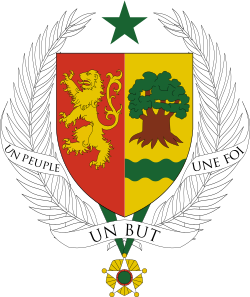Symbolism
The colours and objects on the coat of arms carry cultural, political, and regional meanings. The green star at the crest is identical to the one on Senegal's flag. [4] It alludes to Islam, the religion practiced by 94% of Senegal's population. [5] [6] [7] It is also possible that it might have derived from the Serer religious symbol "Yoonir" which has been used as a religious and cultural symbol by the Serer people of Senegal, the Gambia and Mauritania long before Islam penetrated the Senegambia region, and long before it became an Islamic symbol - with roots to the Ottoman Empire flag. For more on the five-pointed star's Serer religious connection, see the Serer creation myth and Yoonir. President Léopold Sédar Senghor, under whose administration this coat was drawn was not a Muslim but a Roman Catholic. He was also a Serer and a strong advocate for Serer religion and culture - even in his works.
The dexter (i.e. proper right) of the escutcheon features a lion. A national symbol of Senegal, [7] it stands for strength [3] and represents the northern Senegalese ethnic group, which forms the majority of the population. Historically it was a symbol of power for kings, before the French colonised Senegal. [8]
On the arms' sinister, a baobab tree is depicted, which is native to Senegal. Located just beneath it is a green wavy line that epitomises the Senegal River. [3] The order underneath the escutcheon is that of the National Order of the Lion. Both the lion and the baobab tree, which featured previously on earlier Senegalese emblems, [4] are now utilised on the country's two seals. [8] The seal with the baobab tree is used to stamp any acts relating to public administration, while the lion seal is used exclusively by the President for significant acts of state, such as international agreements. [8]



